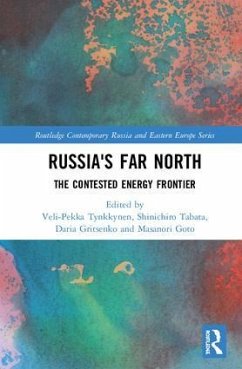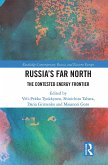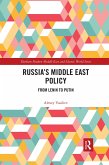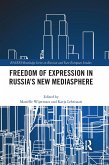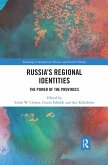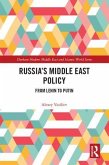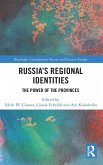Russia's Far North
The Contested Energy Frontier
Herausgeber: Tynkkynen, Veli-Pekka; Gritsenko, Daria; Tabata, Shinichiro
Russia's Far North
The Contested Energy Frontier
Herausgeber: Tynkkynen, Veli-Pekka; Gritsenko, Daria; Tabata, Shinichiro
- Gebundenes Buch
- Merkliste
- Auf die Merkliste
- Bewerten Bewerten
- Teilen
- Produkt teilen
- Produkterinnerung
- Produkterinnerung
The Russian Far North is immensely rich in resources, both energy and other resources, and is also one of the least developed regions of Russia. This book presents a comprehensive overview of the region and how it is likely to develop in future.
Andere Kunden interessierten sich auch für
![Russia's Far North Russia's Far North]() Russia's Far North58,99 €
Russia's Far North58,99 €![Russia's Middle East Policy Russia's Middle East Policy]() Alexey VasilievRussia's Middle East Policy60,99 €
Alexey VasilievRussia's Middle East Policy60,99 €![Freedom of Expression in Russia's New Mediasphere Freedom of Expression in Russia's New Mediasphere]() Freedom of Expression in Russia's New Mediasphere58,99 €
Freedom of Expression in Russia's New Mediasphere58,99 €![Russia's Regional Identities Russia's Regional Identities]() Russia's Regional Identities59,99 €
Russia's Regional Identities59,99 €![Russia's Middle East Policy Russia's Middle East Policy]() Alexey VasilievRussia's Middle East Policy231,99 €
Alexey VasilievRussia's Middle East Policy231,99 €![Russia's Regional Identities Russia's Regional Identities]() Russia's Regional Identities229,99 €
Russia's Regional Identities229,99 €![Russia's Iron Age Russia's Iron Age]() William Henry ChamberlinRussia's Iron Age35,99 €
William Henry ChamberlinRussia's Iron Age35,99 €-
-
-
The Russian Far North is immensely rich in resources, both energy and other resources, and is also one of the least developed regions of Russia. This book presents a comprehensive overview of the region and how it is likely to develop in future.
Hinweis: Dieser Artikel kann nur an eine deutsche Lieferadresse ausgeliefert werden.
Hinweis: Dieser Artikel kann nur an eine deutsche Lieferadresse ausgeliefert werden.
Produktdetails
- Produktdetails
- Verlag: Routledge
- Seitenzahl: 270
- Erscheinungstermin: 14. März 2018
- Englisch
- Abmessung: 240mm x 161mm x 19mm
- Gewicht: 573g
- ISBN-13: 9781138307544
- ISBN-10: 1138307548
- Artikelnr.: 52458187
- Herstellerkennzeichnung
- Libri GmbH
- Europaallee 1
- 36244 Bad Hersfeld
- gpsr@libri.de
- Verlag: Routledge
- Seitenzahl: 270
- Erscheinungstermin: 14. März 2018
- Englisch
- Abmessung: 240mm x 161mm x 19mm
- Gewicht: 573g
- ISBN-13: 9781138307544
- ISBN-10: 1138307548
- Artikelnr.: 52458187
- Herstellerkennzeichnung
- Libri GmbH
- Europaallee 1
- 36244 Bad Hersfeld
- gpsr@libri.de
Veli-Pekka Tynkkynen is a Professor in Russian Energy Policy at the Aleksanteri Institute, University of Helsinki Shinichiro Tabata is a Professor at the Slavic-Eurasian Research Center, Hokkaido University Daria Gritsenko is an Assistant Professor at the Aleksanteri Institute, University of Helsinki Masanori Goto is a Specially Appointed Assistant Professor at the Slavic-Eurasian Research Center, Hokkaido University
Introduction: Contested Russian Arctic, Part 1: Energy and economy,
Chapter 1. Economic Development of the Arctic Regions of Russia, Chapter 2.
Perspectives of Oil and Gas Development in the Russian Arctic, Chapter 3.
Northern Sea Route (NSR) shipping, current status and its feasibility,
Chapter 4. Planning for a Sustainable Arctic: Regional development in the
Yamal-Nenets Autonomous Okrug (Russia), Part 2: Diplomacy and security,
Chapter 5. The Twofold Development of the Arctic - where do the Arctic
states stand? Chapter 6. Potential transboundary maritime energy disputes
in the Arctic: the Russian perspective, Chapter 7. Examining the execution
of Russian military-security policies and programs in the Arctic, Part 3:
Business and environment, Chapter 8. Russian Arctic Development and
Environmental Discourse , Chapter 9. Are Finnish Firms Willing to Explore
the Russian Maritime and Offshore Industry? Perceptions of Finnish SMEs of
the Russian Market and Export Collaboration, Chapter 10. Cutting through
Channels: Local Entrepreneurship of Indigenous Actors in Arctic Russia,
Chapter 11. Disappearing White Fish and Remaining Black Fish in the Lower
Ob' River and Its Tributaries: Conflict over the Use of Fish Resources
between Indigenous People and Non-locals, Part 4: Identity and community,
Chapter 12. Telling domestic and international policy stories: The case of
Russian Arctic policy, Chapter 13. Simulating Sovereignty: The Role of the
Arctic in Constructing Russian Post-Imperial Identity, Chapter 14. The
Arctic in Russia's Fin-de-Siècle Imagination: The Paintings and Writings of
Aleksandr Borisov, Chapter 15. The image of the Russian North in
I.Bilibin's creative work.
Chapter 1. Economic Development of the Arctic Regions of Russia, Chapter 2.
Perspectives of Oil and Gas Development in the Russian Arctic, Chapter 3.
Northern Sea Route (NSR) shipping, current status and its feasibility,
Chapter 4. Planning for a Sustainable Arctic: Regional development in the
Yamal-Nenets Autonomous Okrug (Russia), Part 2: Diplomacy and security,
Chapter 5. The Twofold Development of the Arctic - where do the Arctic
states stand? Chapter 6. Potential transboundary maritime energy disputes
in the Arctic: the Russian perspective, Chapter 7. Examining the execution
of Russian military-security policies and programs in the Arctic, Part 3:
Business and environment, Chapter 8. Russian Arctic Development and
Environmental Discourse , Chapter 9. Are Finnish Firms Willing to Explore
the Russian Maritime and Offshore Industry? Perceptions of Finnish SMEs of
the Russian Market and Export Collaboration, Chapter 10. Cutting through
Channels: Local Entrepreneurship of Indigenous Actors in Arctic Russia,
Chapter 11. Disappearing White Fish and Remaining Black Fish in the Lower
Ob' River and Its Tributaries: Conflict over the Use of Fish Resources
between Indigenous People and Non-locals, Part 4: Identity and community,
Chapter 12. Telling domestic and international policy stories: The case of
Russian Arctic policy, Chapter 13. Simulating Sovereignty: The Role of the
Arctic in Constructing Russian Post-Imperial Identity, Chapter 14. The
Arctic in Russia's Fin-de-Siècle Imagination: The Paintings and Writings of
Aleksandr Borisov, Chapter 15. The image of the Russian North in
I.Bilibin's creative work.
Introduction: Contested Russian Arctic, Part 1: Energy and economy,
Chapter 1. Economic Development of the Arctic Regions of Russia, Chapter 2.
Perspectives of Oil and Gas Development in the Russian Arctic, Chapter 3.
Northern Sea Route (NSR) shipping, current status and its feasibility,
Chapter 4. Planning for a Sustainable Arctic: Regional development in the
Yamal-Nenets Autonomous Okrug (Russia), Part 2: Diplomacy and security,
Chapter 5. The Twofold Development of the Arctic - where do the Arctic
states stand? Chapter 6. Potential transboundary maritime energy disputes
in the Arctic: the Russian perspective, Chapter 7. Examining the execution
of Russian military-security policies and programs in the Arctic, Part 3:
Business and environment, Chapter 8. Russian Arctic Development and
Environmental Discourse , Chapter 9. Are Finnish Firms Willing to Explore
the Russian Maritime and Offshore Industry? Perceptions of Finnish SMEs of
the Russian Market and Export Collaboration, Chapter 10. Cutting through
Channels: Local Entrepreneurship of Indigenous Actors in Arctic Russia,
Chapter 11. Disappearing White Fish and Remaining Black Fish in the Lower
Ob' River and Its Tributaries: Conflict over the Use of Fish Resources
between Indigenous People and Non-locals, Part 4: Identity and community,
Chapter 12. Telling domestic and international policy stories: The case of
Russian Arctic policy, Chapter 13. Simulating Sovereignty: The Role of the
Arctic in Constructing Russian Post-Imperial Identity, Chapter 14. The
Arctic in Russia's Fin-de-Siècle Imagination: The Paintings and Writings of
Aleksandr Borisov, Chapter 15. The image of the Russian North in
I.Bilibin's creative work.
Chapter 1. Economic Development of the Arctic Regions of Russia, Chapter 2.
Perspectives of Oil and Gas Development in the Russian Arctic, Chapter 3.
Northern Sea Route (NSR) shipping, current status and its feasibility,
Chapter 4. Planning for a Sustainable Arctic: Regional development in the
Yamal-Nenets Autonomous Okrug (Russia), Part 2: Diplomacy and security,
Chapter 5. The Twofold Development of the Arctic - where do the Arctic
states stand? Chapter 6. Potential transboundary maritime energy disputes
in the Arctic: the Russian perspective, Chapter 7. Examining the execution
of Russian military-security policies and programs in the Arctic, Part 3:
Business and environment, Chapter 8. Russian Arctic Development and
Environmental Discourse , Chapter 9. Are Finnish Firms Willing to Explore
the Russian Maritime and Offshore Industry? Perceptions of Finnish SMEs of
the Russian Market and Export Collaboration, Chapter 10. Cutting through
Channels: Local Entrepreneurship of Indigenous Actors in Arctic Russia,
Chapter 11. Disappearing White Fish and Remaining Black Fish in the Lower
Ob' River and Its Tributaries: Conflict over the Use of Fish Resources
between Indigenous People and Non-locals, Part 4: Identity and community,
Chapter 12. Telling domestic and international policy stories: The case of
Russian Arctic policy, Chapter 13. Simulating Sovereignty: The Role of the
Arctic in Constructing Russian Post-Imperial Identity, Chapter 14. The
Arctic in Russia's Fin-de-Siècle Imagination: The Paintings and Writings of
Aleksandr Borisov, Chapter 15. The image of the Russian North in
I.Bilibin's creative work.

